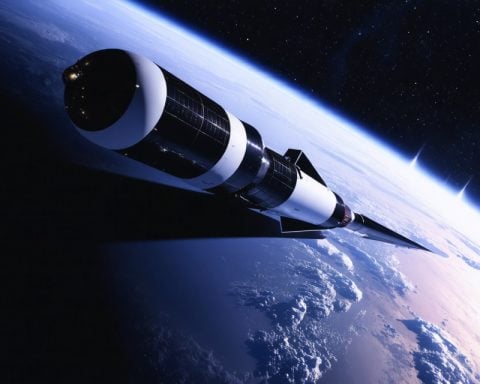In the early hours of October 26, a fascinating event unfolded in Iranian skies as Israel engaged in a strategic assault from afar. The Israeli fighter jets launched a series of ballistic missiles targeting specific sites within Iran. In response, Iranian air defense forces swiftly activated their systems to intercept the incoming threat.
Visual evidence captured by Al Jazeera illustrates the dramatic scene over Tehran. The night sky was lit by bursts of light that experts suggest indicate successful missile interceptions. This type of visual confirmation has become familiar in modern warfare, reminiscent of similar defensive measures seen over cities like Tel Aviv and Kyiv.
Among Iran’s array of defense tools, the spotlight was on the Russian-supplied S-300PMU-2 system. Delivered in 2016, this advanced system boasts a sophisticated suite of radars and launchers designed for a layered defense approach. The S-300PMU-2 is generally complemented by an arsenal intended for long, medium, and short-range missile engagement, boasting significant mobility for enhanced operational survivability.
Notably, the attack targeted a strategic base near Tehran rumored to house advanced S-300 units and possibly the powerful 48N6DM missiles. These missiles are rated for their anti-missile capabilities, capable of intercepting threats moving at incredible speeds.
While it’s unclear if Iran’s S-300 units are indeed equipped with the 48N6DM, the country’s consistent investment in developing indigenous systems like the Bavar-373 underscores its commitment to maintaining a robust and advanced air defense network. Meanwhile, the evolving dynamics between Tehran and Moscow continue to influence Iran’s defense procurement strategies.
The Hidden Impacts of Missile Defense Clashes: Unseen Ripple Effects on Global and Local Scales
Exploring the Unspoken Consequences of Missile Defense Systems
The recent escalation between Iran and Israel not only underscores the ongoing tension in the region but also provides a lens into broader, often overlooked ramifications of such military encounters. These events ripple outwards, affecting far more than just the immediate players involved. Their impacts reach into international relations, economic conditions, and societal structures, reshaping the lives of countless individuals.
The War Economy: Boon and Burden
While advanced missile defense systems, such as Iran’s S-300PMU-2, boast of technological prowess, their deployment underscores the immense resources devoted to military spending. Countries like Iran invest billions in defense, which often diverts funds from critical civic areas such as healthcare, education, and infrastructure. This shift creates a paradox where national security is prioritized at the expense of social welfare, affecting long-term development.
Interestingly, locally, the defense industry stimulates economic activity by providing jobs and driving technology advancements. However, this reliance on military economics can lead to unstable job markets, as industry fortunes are susceptible to the volatile nature of geopolitical tensions.
Technological Push and Ethical Quandaries
The use of advanced systems like the S-300PMU-2 in countering missile threats illustrates the breathtaking technological advancements in modern warfare. However, these developments come with ethical considerations. The proliferation of high-tech weaponry raises concerns about the potential for increased regional conflicts and the lowered threshold for military engagement.
Moreover, the exchange of defense technologies, as seen in the Iranian-Russian dynamic, often results in complex geopolitical alignments that further convolute international relations. Such alliances can have significant impacts on global diplomacy, economic sanctions, and power balances.
Civilian Impact: Living Under the Threat
Communities in areas with heightened military activities often face psychological and social challenges. The threat of missile attacks, frequently depicted by the dramatic night-time interceptions, leaves civilians in a constant state of vigilance and stress, impacting mental health and societal cohesion.
Residents must navigate daily life amidst looming threats, which can lead to increased migration from conflict zones, altering demographic landscapes and placing pressure on surrounding regions and nations.
Advantages and Disadvantages: Weighing the Scale
The advancement of missile defense systems offers a dual-edged sword. On one hand, they can successfully deter aggression, providing a sense of security and military parity. On the other, their presence—and the threat they mitigate—can perpetuate an arms race, encouraging further militarization rather than diplomacy.
The advantages of possessing advanced defensive capabilities include enhanced sovereign security and technological prestige. Conversely, reliance on such measures can reduce investment in peaceful conflict-resolution strategies and escalate regional arms races.
Related Questions and Insights
– How do missile defense systems impact civilian security perceptions?
– While these systems provide a layer of security, they also perpetuate a climate of fear and uncertainty, affecting communal mental health and daily living conditions.
– Why do nations invest so heavily in military technology?
– Nations pursue military technology to maintain sovereignty and deterrence, but this can burden national budgets, often at the expense of essential social services.
For further exploration into military defense technologies and geopolitical strategies, visit Al Jazeera and BBC.
The article has been updated: 2024-11-08 23:54
Here are some suggested related links:
1. Reuters – Leading global news organization providing updates on international affairs, including the Iranian defense strategies and regional conflicts.
2. Al Jazeera – A news organization that offers in-depth coverage and analysis of Middle Eastern politics, including Iranian defense mechanisms and responses to threats.
3. The Washington Post – A major American news outlet that provides extensive reporting on global security issues, including Iranian military developments and Israeli relations.
4. BBC News – Renowned for its comprehensive news coverage, the BBC explores international relations, military strategies, and the implications of missile strikes in the Middle East.
5. Defense News – A trusted source for defense and military news, offering insights on Iranian military capabilities and countermeasures against attacks.
6. Foreign Affairs – Publishes expert analyses on international policies and military strategies, including Iran’s defense posture against Israel.
7. Strategy Page – A resource for military news and analysis that discusses the strategies employed by countries regarding defense and counteroffensive measures.
8. The Drive – Focuses on military technology and defense news, providing details on missile systems and Iran’s technological advancements in defense.
9. CNN – A leading news network that covers breaking news, including developments in Iranian defenses and their responses to Israeli military actions.
10. World Politics Review – Analyzes international relations and geopolitical strategies, including Iranian defense mechanisms in the face of external threats.
The article has been updated: 2024-11-09 13:12
What strategies has Iran implemented to effectively counter Israeli missile strikes?
Iran has developed a multi-faceted defense strategy to counter Israeli missile strikes, incorporating advanced technology and military tactics. Key components include the enhancement of its air defense systems, such as the domestically produced Bavar-373 and Khordad-15, which are designed to detect and intercept incoming missiles. Additionally, Iran has employed a network of decentralized command and control, allowing for rapid response to missile threats.
Furthermore, Tehran has focused on asymmetric warfare techniques, including the use of drones and missiles stationed in various locations across the country to deter and respond to potential strikes. Iran’s strategy also involves conducting military drills to simulate responses to missile attacks, bolstering its readiness against Israeli operations. This comprehensive approach enables Iran to protect its critical infrastructure and maintain a robust counter-offensive capability in the face of external threats.







